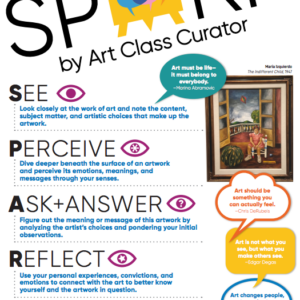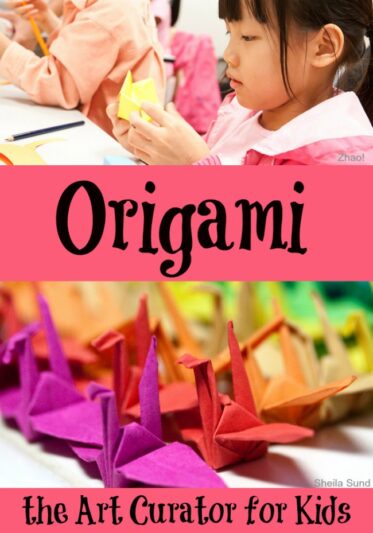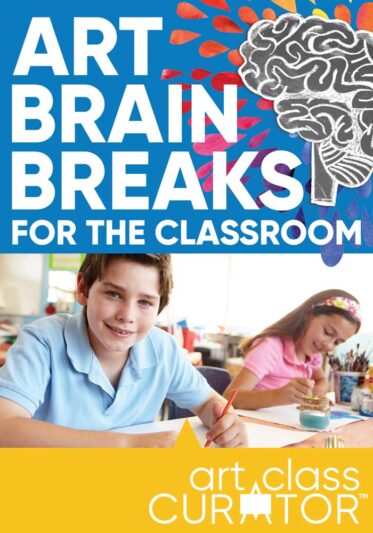Inside: Discover SPARK, the complete art criticism and discussion framework that ignites deeper student art connections and more engaging classroom art discussions. Download a SPARK art criticism steps poster and worksheet for your classroom!

Many of us are familiar with the traditional Feldman model of art criticism steps: Description, Analysis, Interpretation, and Evaluation. But this art criticism model has always felt incomplete to me, especially when teaching an art criticism lesson.
Does this scenario sound familiar? You guide your students through the four steps of art criticism as you’ve been taught them. Together, you describe the physical characteristics of the artwork, analyze the artwork using the elements of art and principles of design as a guide, then the students share their interpretations of the artist’s intent. Finally, you ask for their opinions of the artwork–rarely getting a response beyond “I like it” or “I hate it” from most students.
There’s a reason why the four steps of art criticism leads to lackluster lessons and bland conversations. The traditional art criticism model is too focused on the details. The students are missing the forest for the trees. In order to facilitate engaging, meaningful art discussions, we have to focus on the part we already know inspires deep, critical thinking and unique student insights–personal connection.
Art = Form + Theme + Context + Personal Connection

Artworks that stick with us stay in our hearts and minds because we connect with them on a personal level. They speak to us about the world, ourselves, or something we’re going through. We remember them and they change us–how we think or experience the world, inspiring us or giving us a new lens to look through.
My first real art connection came from The Lion King. To bring powerful, personal artwork connections to students the way The Circle of Life did for me, we have to refocus our attention on what our students see when they look at an artwork. That’s why I reinvented the art criticism steps.
Introducing…
SPARK: 5 Art Criticism Steps for Inspired Art Connections and Engaged Art Discussions

Step 1: See
Look closely at the work of art and note the content, subject matter, and artistic choices that make up the artwork.
Ask: What do you see? How did the artist use the elements of art and principles of design? How would you describe this artwork?
Step 2: Perceive
Dive deeper beneath the surface of the artwork and perceive its emotions, meaning, and messages through your senses.
Ask: What emotions do you feel when looking at this artwork? What is the mood of this artwork? How do you think the artist felt when creating this artwork? Describe this artwork using the five senses.
Step 3: Ask + Answer
Figure out the meaning or message of this artwork by analyzing the artist’s choices and pondering your initial observations.
Ask: What is this artwork about? What are the hidden meanings or messages? What symbols are present in this artwork? What questions would you ask the artist?
Step 4: Reflect
Use your personal experiences, convictions, and emotions to connect with the art to better know yourself and the artwork.
Ask: How can you relate your own life and experiences to this artwork? How might you look at the world or experience the world differently after experiencing this artwork? What can you learn about yourself through this artwork?
Step 5: Know
Use the artwork to learn about history while understanding that it is only one piece of the puzzle. Use observation, critical thinking, art content knowledge, and research to learn what you can about the artwork.
Ask: Who? What? When? Where? Why? What do we know about the person/people who created this artwork based on what we see? Why or for whom did the artist create this artwork and how does that impact the meaning?
Using the SPARK Art Criticism Steps in Your Classroom
When students are asked to think critically about art while considering how it ties in to their own lives and viewpoints, they truly connect with the artwork. The SPARK Framework goes deeper than whether or not students like the artwork. It asks them to consider their worldview and reveals why art matters in their life.
To use the SPARK Art Criticism & Discussion Framework in your classroom, choose an artwork to show your students. Lead a classroom art discussion using the five steps. Ask students to back up their answers to the SPARK questions using evidence from the artwork. Remember, there are no wrong answers as long as your student can back up what they say. Once your students have experienced a few SPARK art discussions, they will be able to use the SPARK worksheet for art criticism.
Free Download




Free Worksheets!
SPARK Art Criticism Framework
SPARK is a complete art criticism and discussion framework that ignites deeper student art connections and more engaging classroom art discussions. Download these free SPARK posters plus a worksheet to use in your classroom!





Hi, I would love to download a copy of the SPARK notes and poster but I can’t seem to get the download button to work. Any advice?
Hi Krysty,
You may be experiencing a strong firewall that blocks our links. Contact us at support@artclasscurator.com and we can get you the resource another way.
Thank you!
Hi there! LOVE this resource, and would love to download it, but the download button doesn’t seem to be working (?) Excited for the upcoming “Beyond the Surface” series!
Thanks so much! The problem has been fixed. You can download now.
Can you show us a worked example of how you have used SPARK?
Thank you!
I recommend our free PD course, Beyond the Surface. You will learn how to utilize SPARK in your classroom.
I am trying to down the SPARK posters and worksheet, but it doesn’t work. What am I doing wrong?
Hmm…I tested it and it seems to work for me, so I am not sure. Just email me at support@artclasscurator.com and I’ll send the downloads if you were not able to get it to work.